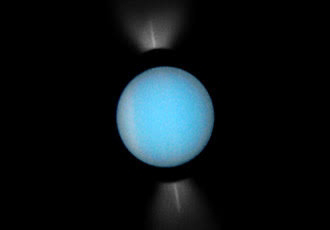Uranus facts : Enlightening facts about the planet Uranus |funfactquotes
Uranus is the seventh planet in distance from the Sun. It is the third largest planet by diameter while the fourth in mass. Uranus is larger in size than Neptune but less in mass.
Planet Uranus Profile - Planet Uranus
Distance from Sun: 287 crore 6 lakh 58 thousand 186 kilometers or 19.22 AU (1 AU = distance of Sun from Earth)
➡ Known Satellites: 27
➡ Mass: 86,81,030 billion kg
➡ Ground - Central Reaches Diameter: 51,118 km
➡ Polar diameter: 49,964 km
ल Length of geo-midline: 159,354 km
➡ One year: equivalent to 84.2 years of Earth or 30,685.15 days
➡ surface temperature: -197 ° C
➡ Search date: 13 March 1781, by William Herschel
Interesting facts about the planet Uranus - About Uranus Planet
1. Uranus is the first planet to be discovered in the modern era. It is located at a much greater distance from Earth than Mercury, Venus, Mars, Jupiter and Saturn, due to which it cannot be easily seen with naked eyes. John Flemstein was the first to record this planet, but at that time he ignored it as a star and classified it as a star named '34 Tauri'. On 13 March 1781, William Herschel observed it with his telescope and said that it is not a star but a planet. He had seen it before but had considered it a star just like Flemstein. He wanted to name it 'George's star' after King George III, but astronomer Bode named it Uranus as a tradition of naming planets after the gods of Greek mythology. Uranus is the king of heaven in Greek stories.
2. Uranus completes a circle in front of its axis in 17 hours and 14 minutes. It revolves in the opposite direction from all the planets, including the Earth, in front of its axis. Uranus rotates from east to west while the other planets including Earth rotate from west to east.
3. The axis (axis) of the planet Uranus is similar to that of the solar system, which makes it appear that it is rotating the Sun's orbit. For this reason, one of its poles remains for 42 years in front of the sun, while another 2 years in darkness.
4. Uranus is also known as ‘ice giant’ planet as it is mainly made up of different types of ice. Apart from this, it is made of rocks, hydrogen and a small amount of helium. Its atmosphere contains 83% hydrogen, 15% helium and 2% methane.
5. Even though the planet Neptune is located far away from Uranus, Uranus is colder than all other planets including Neptun. The average temperature of its atmosphere is at least -224 ° C.
6. Uranus's color appears blue in the pictures taken so far. This is due to the red color being absorbed by the methane present in its upper part.
7. Below the methane above the planet Uranus are clouds of clouds. These strips are not easily seen due to the methane at the top, but they can be seen by looking carefully at the images taken by Vyjar 2.
8. Like other gas planets, Uranus also has a ring. So far, 13 known rings have been discovered. Its ring is not as bright as that of Saturn but is blurred. After Saturn, the rings of Uranus were the first to be seen, which showed that all gassy planets have rings. Saturn does not have a monopoly in it.
9. So far 27 moons of Uranus have been discovered. 5 of them are large while the rest are small. But if we add the mass of all these, then it will be less than half the mass of Neptun's largest moon Triton. The diameter of Titania, the largest moon in Uranus, is about half the diameter of the Earth's moon. Scientists speculate that there may be more moons between the rings of Uranus.
10. The satellites of Uranus are named after the characters of the works of Shakespeare and Alexander Pope.
11. Uranus can be easily seen from the naked eye from the earth, but sometimes it can be seen from the clear sky of the night. But it can be easily seen with binocular or small binoculars.
12. So far, only one spacecraft has visited the planet Uranus. NASA's wager reached 2 January 1986 near Uranus. It started circling 81,000 kilometers above the surface of Yures. It discovered 11 small moons of this planet. It sent thousands of pictures of Uranus, its satellites and rings (rings).

Comments
Post a Comment